Prepare for a Winter Storm with These Safety Tips
Winter weather can often mean fun – sledding, building snowmen and warming up afterward with a mug of hot cocoa. But you should always take winter weather seriously, especially when your local weather authorities warn of hazardous conditions. Severe winter weather can be dangerous, or even deadly.
Let’s take a look at some of the most serious threats that winter weather can pose, as well as a few tips to help keep your family, home and vehicles safe.
Types of Winter Storms
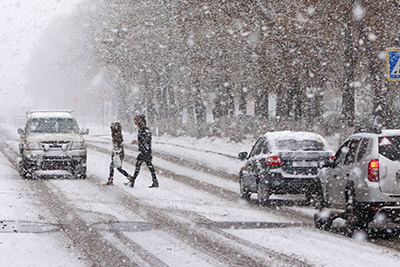
Not all winter storms are alike. Precipitation, wind and temperature can vary even within a single storm system, and when temperatures are low and precipitation and winds are intense, it’s essential that you seek shelter and monitor the conditions.
You may encounter a few different types of precipitation throughout the winter storm season:
- Snow, which can vary from light and fluffy to wet and heavy. Snow accumulation can cover walkways and roadways, making travel difficult.
- Sleet, which occurs when snowflakes melt and then refreeze on their way to the ground. Sleet can create slipping and driving hazards.
- Freezing rain, which occurs when snowflakes melt completely on their way to the ground. Freezing rain often turns to ice once it lands on surfaces.
Snow Storms, Ice Storms and Blizzards
You may also hear meteorologists talk about specific types of winter storm systems, including:
- Snowstorms. Snow described as “flurries” is usually light with little to no accumulation. “Snow showers” are heavier and may accumulate on the ground.
- Ice storms. These storms create ice accumulation of at least a quarter inch, typically through freezing rain turning to ice on surfaces. Ice storms can make driving and even walking hazardous, and can cause tree branches and power lines to fall down.
- Blizzards. A winter storm is a blizzard when it creates dangerously low visibility from windblown snow. A storm doesn’t need heavy snowfall to be a blizzard – in fact, it doesn’t need to be snowing at all if there’s enough snow accumulation on the ground. These storms may be called “ground blizzards.”
- Snow squalls. Common in the Great Lakes region, these storms tend to be brief but intense, with strong winds and often heavy snowfall. Certain types of snow squalls are called “lake effect storms.” Because of their short duration and intensity, you should shelter in place and avoid driving when a snow squall is passing through.
How to Prepare for Winter Storms
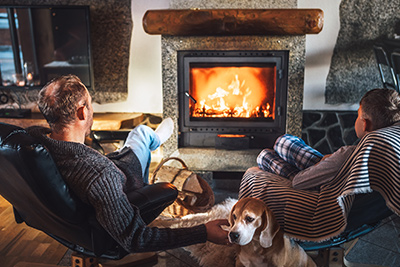
As with any type of severe weather, preparation is key to remaining comfortable and safe throughout a winter storm. To make sure you’re prepared, consider taking these steps in advance, when the weather is calm:
- Assemble an emergency kit. A good emergency kit includes at least a three-day supply of nonperishable food and bottled water (at least one gallon per person, per day) for everyone in the home. A first aid kit, battery-operated radio, flashlights and spare batteries are also important. Consider other special items based on your needs, like pet food and prescription medications.
- Create a family communications plan. When severe weather strikes, having a plan to keep in touch can help ensure everyone shelters safely in place, even if they’re separated.
- Get quality winter outerwear. This should include a warm coat, hat, gloves and waterproof boots.
- Winterize your home. Seal cracks and air leaks around your home, and replace door and window weather stripping if it has fallen into disrepair. Trim tree branches that hang over your roof or nearby power lines.
- Winterize your vehicle. This includes topping off engine coolant, replacing worn wiper blades and tires, servicing the brake system and keeping the gas tank as full as possible. You may want to keep winter weather emergency supplies in the trunk, including a compact snow shovel, a bag of sand or kitty litter to help dislodge stuck tires, and blankets and snacks in case you become temporarily stranded.
- Sign up for emergency weather alerts. If you have a smartphone, there are several apps that can alert you to dangerous weather conditions. If you have another type of mobile phone, you can usually sign up for free emergency text alerts from your local government, news stations and energy utilities.
Staying Safe During and After Winter Storms
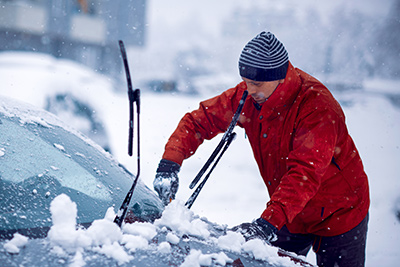
With your preparations in place, you should be in a good position to weather a winter storm safely. But your best course of action during the storm itself depends on where you are when severe weather strikes.
If you’re indoors:
- Remain inside. Use warm clothing, blankets and safe, appropriate heating systems to stay warm.
- Activate your family communications plan if you’re separated from your loved ones.
- Monitor weather conditions via radio, TV or smartphone, and pay attention to any emergency instructions.
If you’re outdoors:
- Seek the nearest shelter. Use caution if surfaces are slippery or if there is low visibility.
- Stay dry and dress warmly until you’re able to reach an appropriate shelter.
- Call 911 if you have a phone and are unable to find or reach shelter.
- Activate your family communications plan once you reach a safe shelter to let your loved ones know you’re safe.
If you’re in a vehicle:
- Reduce your speed. Even light winter storms can present driving hazards.
- Change your travel plans to get off the road and into a shelter as soon as possible if driving conditions become dangerous.
- React calmly if your car skids on snow or ice. Ease your foot off the gas pedal and gently steer in the direction you want the front of your car to go. If your vehicle has anti-lock brakes, apply gentle, steady pressure to the brake pedal. If not, gently pump the brakes. When the vehicle regains traction, ease back onto the gas pedal and finish correcting your steering.
- Pull over onto the side of the road and stop if conditions suddenly become too slippery, have low visibility or are otherwise dangerous. Turn on your emergency blinkers to help other motorists see you.
- If you become stuck in snow, remain in your vehicle and call for help. Run the engine occasionally, but not continuously, to keep your car warm while conserving gas. If snow is accumulating around your car, leave the car periodically to clear snow away from your exhaust pipe so that you don’t create a carbon monoxide hazard.
After a storm:
- Examine your property inside and out for storm-related damage. Take photographs of any damage you find and, where applicable, report the damage to your homeowners insurance carrier.
- Carefully shovel walkways around your home. Take breaks and don’t overexert yourself. If you have health issues, especially heart health concerns, you should avoid this task.
- Continue to monitor news and weather reports. If you hear reports of messy road conditions, continue to avoid driving until those conditions improve.
- If you see downed power lines, don’t approach them. Call your local electrical utility to report the problem.
Looking for Something Specific?
Select a category to find resources for topics that interest you.
Select Category

Related Articles:

What to Do Before, During and After Power Outages
With a little knowledge and preparation, you can protect yourself, your home and your belongings during power outages of any duration.
Read Article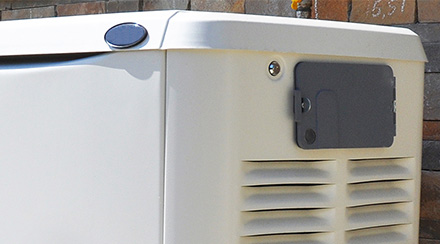
How to Choose a Generator for Your Home
Power outages can be miserable, but with the right generator, you can keep your family safe and comfortable until power is restored. Learn how to choose the best generator for your home.
Read Article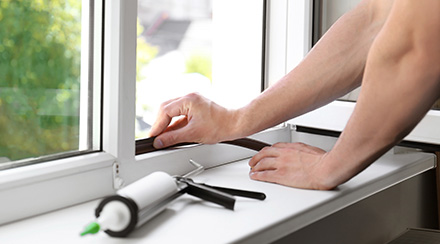
Weatherize Your Home for Summer
The extreme heat of summer can really do a number on your energy bills. But if you’re able to invest a little time and money into weatherizing to keep your home cool, you can help yourself and your family remain comfortable at home while still saving energy.
Read ArticlePrepare for a Winter Storm with These Safety Tips
Winter weather can often mean fun – sledding, building snowmen and warming up afterward with a mug of hot cocoa. But you should always take winter weather seriously, especially when your local weather authorities warn of hazardous conditions. Severe winter weather can be dangerous, or even deadly.
Let’s take a look at some of the most serious threats that winter weather can pose, as well as a few tips to help keep your family, home and vehicles safe.
Types of Winter Storms
Not all winter storms are alike. Precipitation, wind and temperature can vary even within a single storm system, and when temperatures are low and precipitation and winds are intense, it’s essential that you seek shelter and monitor the conditions.
You may encounter a few different types of precipitation throughout the winter storm season:
- Snow, which can vary from light and fluffy to wet and heavy. Snow accumulation can cover walkways and roadways, making travel difficult.
- Sleet, which occurs when snowflakes melt and then refreeze on their way to the ground. Sleet can create slipping and driving hazards.
- Freezing rain, which occurs when snowflakes melt completely on their way to the ground. Freezing rain often turns to ice once it lands on surfaces.
Snow Storms, Ice Storms and Blizzards
You may also hear meteorologists talk about specific types of winter storm systems, including:
- Snowstorms. Snow described as “flurries” is usually light with little to no accumulation. “Snow showers” are heavier and may accumulate on the ground.
- Ice storms. These storms create ice accumulation of at least a quarter inch, typically through freezing rain turning to ice on surfaces. Ice storms can make driving and even walking hazardous, and can cause tree branches and power lines to fall down.
- Blizzards. A winter storm is a blizzard when it creates dangerously low visibility from windblown snow. A storm doesn’t need heavy snowfall to be a blizzard – in fact, it doesn’t need to be snowing at all if there’s enough snow accumulation on the ground. These storms may be called “ground blizzards.”
- Snow squalls. Common in the Great Lakes region, these storms tend to be brief but intense, with strong winds and often heavy snowfall. Certain types of snow squalls are called “lake effect storms.” Because of their short duration and intensity, you should shelter in place and avoid driving when a snow squall is passing through.
How to Prepare for Winter Storms
As with any type of severe weather, preparation is key to remaining comfortable and safe throughout a winter storm. To make sure you’re prepared, consider taking these steps in advance, when the weather is calm:
- Assemble an emergency kit. A good emergency kit includes at least a three-day supply of nonperishable food and bottled water (at least one gallon per person, per day) for everyone in the home. A first aid kit, battery-operated radio, flashlights and spare batteries are also important. Consider other special items based on your needs, like pet food and prescription medications.
- Create a family communications plan. When severe weather strikes, having a plan to keep in touch can help ensure everyone shelters safely in place, even if they’re separated.
- Get quality winter outerwear. This should include a warm coat, hat, gloves and waterproof boots.
- Winterize your home. Seal cracks and air leaks around your home, and replace door and window weather stripping if it has fallen into disrepair. Trim tree branches that hang over your roof or nearby power lines.
- Winterize your vehicle. This includes topping off engine coolant, replacing worn wiper blades and tires, servicing the brake system and keeping the gas tank as full as possible. You may want to keep winter weather emergency supplies in the trunk, including a compact snow shovel, a bag of sand or kitty litter to help dislodge stuck tires, and blankets and snacks in case you become temporarily stranded.
- Sign up for emergency weather alerts. If you have a smartphone, there are several apps that can alert you to dangerous weather conditions. If you have another type of mobile phone, you can usually sign up for free emergency text alerts from your local government, news stations and energy utilities.
Staying Safe During and After Winter Storms
With your preparations in place, you should be in a good position to weather a winter storm safely. But your best course of action during the storm itself depends on where you are when severe weather strikes.
If you’re indoors:
- Remain inside. Use warm clothing, blankets and safe, appropriate heating systems to stay warm.
- Activate your family communications plan if you’re separated from your loved ones.
- Monitor weather conditions via radio, TV or smartphone, and pay attention to any emergency instructions.
If you’re outdoors:
- Seek the nearest shelter. Use caution if surfaces are slippery or if there is low visibility.
- Stay dry and dress warmly until you’re able to reach an appropriate shelter.
- Call 911 if you have a phone and are unable to find or reach shelter.
- Activate your family communications plan once you reach a safe shelter to let your loved ones know you’re safe.
If you’re in a vehicle:
- Reduce your speed. Even light winter storms can present driving hazards.
- Change your travel plans to get off the road and into a shelter as soon as possible if driving conditions become dangerous.
- React calmly if your car skids on snow or ice. Ease your foot off the gas pedal and gently steer in the direction you want the front of your car to go. If your vehicle has anti-lock brakes, apply gentle, steady pressure to the brake pedal. If not, gently pump the brakes. When the vehicle regains traction, ease back onto the gas pedal and finish correcting your steering.
- Pull over onto the side of the road and stop if conditions suddenly become too slippery, have low visibility or are otherwise dangerous. Turn on your emergency blinkers to help other motorists see you.
- If you become stuck in snow, remain in your vehicle and call for help. Run the engine occasionally, but not continuously, to keep your car warm while conserving gas. If snow is accumulating around your car, leave the car periodically to clear snow away from your exhaust pipe so that you don’t create a carbon monoxide hazard.
After a storm:
- Examine your property inside and out for storm-related damage. Take photographs of any damage you find and, where applicable, report the damage to your homeowners insurance carrier.
- Carefully shovel walkways around your home. Take breaks and don’t overexert yourself. If you have health issues, especially heart health concerns, you should avoid this task.
- Continue to monitor news and weather reports. If you hear reports of messy road conditions, continue to avoid driving until those conditions improve.
- If you see downed power lines, don’t approach them. Call your local electrical utility to report the problem.
Looking for Something Specific?
Select a category to find resources for topics that interest you.
Select Category

Related Articles:

What to Do Before, During and After Power Outages
With a little knowledge and preparation, you can protect yourself, your home and your belongings during power outages of any duration.
Read Article
How to Choose a Generator for Your Home
Power outages can be miserable, but with the right generator, you can keep your family safe and comfortable until power is restored. Learn how to choose the best generator for your home.
Read Article
Weatherize Your Home for Summer
The extreme heat of summer can really do a number on your energy bills. But if you’re able to invest a little time and money into weatherizing to keep your home cool, you can help yourself and your family remain comfortable at home while still saving energy.
Read Article






